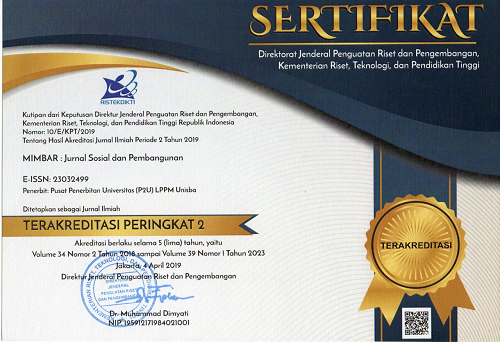Analisis Kinerja Bagian Pengaduan Masyarakat Sekretariat Jenderal DPR RI
Abstract
This study discusses about the performance of the Public Complaints Section, Secretariat General of the House of Representatives in managing the delivery process of public aspirations and complaints. To deepen the analysis, this research incorporates the concepts of organization, bureaucracy, and performance. This study applies a qualitative approach with descriptive type of writing. This study collects data through literature studies, interviews, and field observations. This study reveals that the Public Complaints Section has problems in terms of quantity and quality of human resource analysts. Public Complaints Section is neither effectively nor efficiently able to manage complaints and aspirations of the community. This makes the performance of Public Complaints Section underperformed. Finally, this study recommends that the General Secretariat of Parliament has to optimize the quantity and quality of human resources in the Public Complaints Section. Furthermore, members of the House of Representatives are expected to involve in empowering the section.
Keywords
Full Text:
PDF (Bahasa Indonesia)References
Ariany, Ria.,& Putera Roni Ekha. (2013). Analisis Kinerja Organisasi Pemerintah dalam Memberikan Pelayanan Publik di Kota Pariaman. Jurnal Mimbar LPPM Unisba, Vol.29, No.1 (Juni), pp: 33-40
Blau, Peter M., & Meyer, Marshal W. (1987). Birokrasi dalam Masyarakat Modern (2nd ed) (Gary R. Jusuf: penerjemah). Jakarta: UI Press.
Fahmi, Irham. (2010), Manajemen Kinerja: Teori dan Aplikasi. Bandung: Alfabeta.
Fox, Janice Langan., & Cooper CBE, Cary L., & Klimoski, Richard J. (2007).Research Companion to the Dysfunctional Workplace ManagementChallenges and Symptoms. Cheltenham: Edward Elgar Publishing Limited.
Gaffar, Janedjri M. (2012). Demokrasi Konstitusional: Politik Ketatanegaraan Indonesia Setelah Perubahan UUD 1945 (Cet.1). Jakarta: Konstitusi Press.
Lubis, Hari S.B & Huseini, Martani. (2009). Pengantar Teori Organisasi: Suatu Pendekatan Makro. Jakarta: Departemen Ilmu Administrasi FISIP UI.
McAuley, John.,& Duberley, Joanne., & Johnson, Phil. (2007). Organization Theory: Challenges and Perspectives. Harlow: Pearson Education Limited.
Poister, Theodore H. (2003).Measuring performance in public and nonprofit organizations. San Fransisco: John Wiley & Sons, Inc.
Rahminawati, Nan.,& AR, Hendarsyah N.,& Umar Muthia. (2006), Kemampuan Manajerial Pengurus Organisasi Dalam Upaya Meningkatkan Kinerja Organisasi Islam Perempuan di Jawa Barat, Jurnal Mimbar Unisba, Vol.22, No.2 (April-Juni),pp 143- 164
Ravitch, Diane & Thernstrom, Abigail (Ed.).(1994). Demokrasi Klasik dan Modern (Cet.1) (Hermoyo, Penerjemah). Jakarta: Yayasan Obor Indonesia.
Said, M. Mas'ud. (2009). Birorkasi di Negara Demokratis: Makna, masalah, dan Dekonstruksi Birokrasi di Indonesia. Malang: UMM Press.
Supardi, Anwar Syaiful. (2004). Dasar-Dasar Perilaku Organisasi (Cet.2). Yogyakarta: UII Press.
Tangkilisan, Hessel Nogi S. (2007).Manajemen Publik (Cet.2). Jakarta: PT Grasindo.
Tika, Moh Pabundu. (2008). Budaya Organisasi dan peningkatan Kinerja Perusahaan (Cet.2). Jakarta: PT Bumi Aksara.
Thoha, Miftah. (2012). Birokrasi dan Politik di Indonesia (Cet.9). Jakarta: PT Raja Grafindo Persada.
Tompkins, Jonathan R. (2005). Organization Theory and Public Management. Boston: Wadsworth Cengage learning.
DOI: https://doi.org/10.29313/mimbar.v31i1.1305
Refbacks
- There are currently no refbacks.
MIMBAR : Jurnal Sosial dan Pembangunan is licensed under Creative Commons Attribution-NonCommercial-ShareAlike 4.0 International License.















